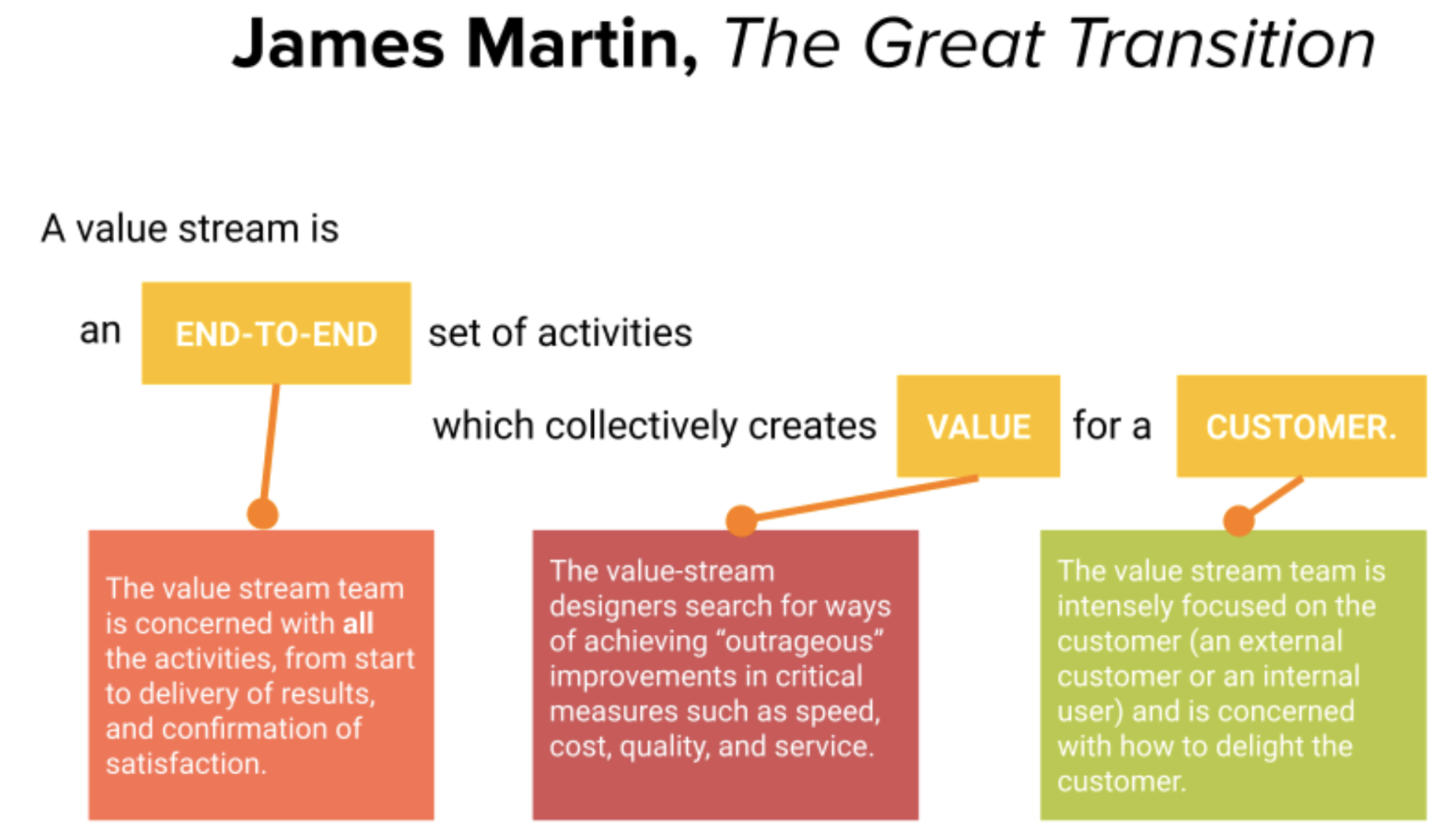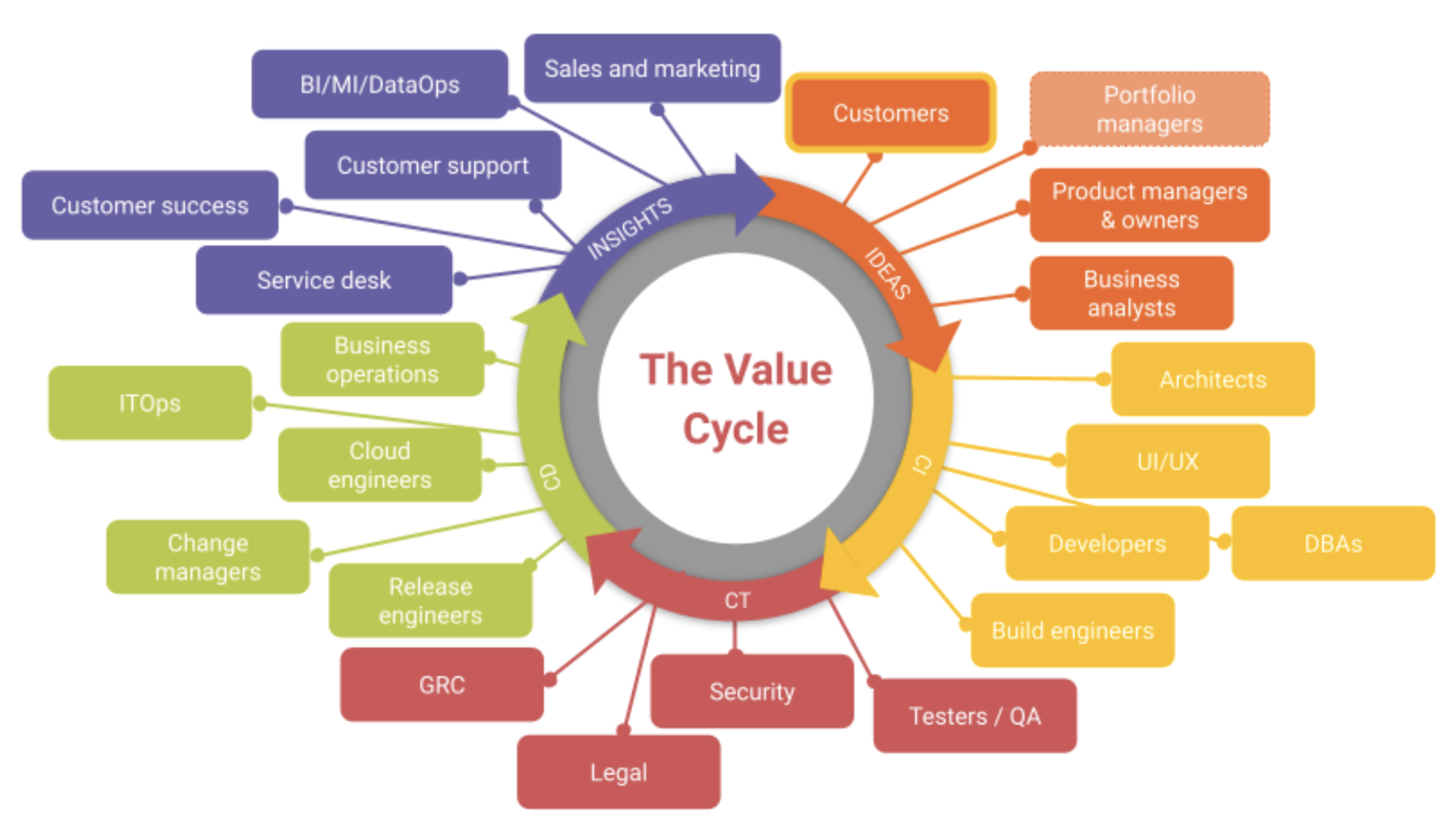The Value Stream Management (VSM) Implementation Roadmap is a series of high-level steps to guide an organization adopting VSM ways of working. Each step creates a foundation for the next, leading to the evolution of an organization that holistically practices insights-driven VSM-led practices that continually optimize customer experience. Let’s explore each of these steps in detail.

Contents
Start: Pass Go
We say that you can start adopting Value Stream Management from wherever you are. We’re making the assumption, in the context of our work, that you have digital value streams but regardless, all businesses, by their very nature, are a network of value streams. All organizations are created to serve a customer or someone—a citizen for example, in the context of government. Companies, whether for profit or not, create products or services whether their own IP or they are distributing or reselling someone else’s.
And every time there’s an idea for an enhancement or change to that product or service, that needs to be designed, developed, and delivered before the customer can extract value from it. Yes, many organizations embarked on agile transformation yonks ago, same for DevOps, even more so for lean. They may be considering or in the middle of a reorganization or merger or acquisition. None of these things mean they are any more or any less ready to embrace value stream ways of working—but change fatigue can get in the way.
The barriers to Value Stream Management adoption don’t include readiness—they relate to a lack of leadership support and perceived resource constraints. Those with vision should seek forgiveness not permission and drag leaders with them. They know that those perceived resource constraints disappear when the waste is removed from the system and capacity is released.
Assess
The Assess step is borne from the work that we have been doing with our Consulting Huddle at the VSMC* and the importance of being able to both baseline the current state when embarking on a journey, and being able to measure progress as an organization progresses on their journey.
The Consulting Huddle collaborated on building a VSM Assessment with question sections that align with the steps in the roadmap. It’s designed for consultants and enterprise practitioners—change agents—to use at the start and for continuous reassessment during their VSM implementation.
*Our VSM Huddles are small communities within the VSM Consortium who meet regularly to help each other with implementation challenges, do research, and publish thought leadership
Vision
There are few exceptions to the truism that you should know your destination before embarking on your journey—and this definitely isn’t one of them. All change initiatives require great effort to repel resistance and fight through existing systems. Changing ways of working requires changing ways of thinking and it’s hard. Fundamentally, it means leading swathes of humans through a learning process until what they have learned has stuck—has become a habit—“the way we do things around here”. Most organizations don’t have huge amounts of fat, even if they appear bloated from the outside. Most people are using all their available hours doing the things they are asked to do to create new things, not stopping to look at how they do things and figure out how they can work smarter and inject capacity for innovation into the systems. The long-term vision for value stream management can be described as:
“Our organization is continually optimizing for the flow of value outcomes to our customers. Waste is continually identified and removed. Customer experience is understood, real-time and learnings produce actioned insights. Aligned with our cost and revenue models, we are in the optimal position for organizational performance."
The goals that relate to this vision, relate to organizational performance. In the context of a digital, for-profit business, these are likely to be something like:
- We respond to and anticipate our customers’ needs instantly and know how our changes create value outcomes
- Our work is visible—we can see where we have delays, idle time, and dependencies
- Value streams have autonomy for their own P&L and all meet their investment targets
- Our organization is able to outcompete in terms of differentiating features, market share, and profitability
The key to all of these goals is measurability:
- How fast we can deliver change and what we know about the value outcome
- The improvements we make to our cycle time and how changes impact customer experience
- The value stream costs less to run than it delivers in income to the business
- We are market leaders
There may be overlap here with existing initiatives such as digital, agile, or DevOps transformation programs. Outcome mapping is a useful tool for leaders here. It’s true that leaders, in command and control organizations, have accountability for strategy but it’s also true that product or value stream teams also contain strategic thinkers. In any change, transformation, or evolution program, empowering people to participate in the change (rather than doing it to them or for them) is pivotal to success. So leaders need to bring teams on their journey—but they should be clear on their views before they start—but also willing to be challenged and learn from their teams’ experiences.
Let’s revisit our example and break it down into what it means for the organization:
"Our organization is continually optimizing for the flow of value outcomes to our customers. Waste is continually identified and removed. Customer experience is understood, real-time and learnings produce actioned insights. Aligned with our cost and revenue models, we are in the optimal position for organizational performance.”
Translates to:
|
Goal |
Outcome |
|
Improving customer experience and value (delivering the right things at the right time) |
Higher customer basket size, retention, reviews, and referrals |
|
SUBGOAL |
Faster flow of valuable changes to customers |
|
SUBGOAL |
Faster and more accurate decision-making |
|
SUBGOAL |
Satisfy financial criteria with each effort, demonstrate positive ROI |
Each of these outcomes can be measured to show progress and results. That means teams and individuals have clear targets to aim for. You can see how a vision can become a very tangible, measurable thing - and it pays to start small.
|
Transformation or Evolution? The word “transformation” is well established in our industry’s culture but there are many challenges to its effectiveness. Sources like McKinsey say that most (70% or more) transformations fail. Forbes says: “Therefore, we need to stop thinking about “transformation” as something that is fixed. We should start thinking about “transforming,” where we identify a direction but do not attempt to fully control the process nor detail the outcome. By viewing organizations as evolving organisms, leaders can recognize that they are not in full control. Leaders should set a direction, connected to the organizational vision, and empower teams across the company to change at the necessary pace reasonable for their employees and customers as well as recognize ongoing transformation planning.” Lean principle Kaizen recognizes that big changes have big (and negative) impacts on productivity, but seeing the organizational change in ways of working as evolutionary smooths the journey and sets the foundation for long-term success. |
Identify
The next step is to surface the value streams. This can be tough for organizations working in project-centric ways. A project is not a value stream—but it may align to a value stream. The problem with projects is that they are short-lived—yes, even if they last for eighteen months or more. But when we think like products, long-lived products, we are starting to see the value streams. In a sense, anything that delivers a product or a service is a value stream. Here’s a definition for a value stream you might want to use:
“Our value streams are identified by having a customer at the end of them—at the start there is an idea and then there are several steps we follow to bring that idea to life and deliver it to the customer and receive feedback.”
You can also refer to this post we wrote on What is a Value Stream? You’ll likely find you have lots of different products and services and that they seem to overlap and interconnect. You may discover you have many different types of customers—some may be internal, some may be external. This is all okay.

Different practitioners and frameworks define different types of value streams, but we prefer to stick to just two types—core and supporting. Because we believe we are living in the digital age and that software has eaten the world, we elevate all digital value streams to core. This is something you will likely want to debate with your teams and the customer is key to the context here. This means all other value streams become supporting. So here are a couple of examples:
- If your business is mainly selling physical or virtual products or services (e.g. consumables, training videos) to consumers, your eCommerce system is a core value stream. Supporting it is your DevOps toolchain platform value stream and your cloud infrastructure platform value stream. Your CRM would also be a supporting value stream. Your mobile app may also be a core value stream. If you are using APIs, and they are shared across multiple value streams, the API platform value stream is supporting. You’re probably seeing a trend here—platforms are supporting value streams and generally value streams that cross multiple value streams are supported.
- If your business is managing other businesses’ wealth for them, you’re an investment bank, for example, your trading platforms would be your core value stream. Your CRM is supporting as is the underlying infrastructure. You might be one part of a larger bank that serves retail customers in addition to commercial banking clients. Those services may include bank accounts, credit cards, loans, mortgages, and insurance. Those are all likely value streams that may contain multiple value streams, for example, insurance may include household, buildings, vehicle, life, health, and pet insurance. These value streams may share applications such as Pega that are managed by a core banking applications team—counterintuitively, that’s a supporting value stream.
It’s sounding pretty complicated, right? Don’t panic though because all the best change initiatives are undertaken incrementally. Start small, experiment, and learn. The more you visualize, the more you map (coming up soon!) the more you’ll discover, see and understand. Don’t try to boil the ocean. One by one, find and name the products, services, and platforms that deliver value to customers (internal and external). Identify the customers. Identify where they start and establish where they end. See where they cross over and connect—map the dependencies.
Organize
Part of the reason that Value Stream Management exists is that we’ve been modeling our organizations around silos. This made sense, particularly when technology was a cost center. But technology is now a strategic enabler—we no longer try to align it to or integrate it with “the business” (A.K.A the rest of the organization)—it IS the business. DevOps started out addressing the problems caused by siloing software development and IT operations teams and quickly graduated to realizing that finance, HR, sales and marketing, product management, and GRC needed to come on the journey too. The problems with siloization are multifold:
- Handoffs. When teams are completing work together every time they pass it on there’s an opportunity to mess it up, slow it down or drop the ball altogether.
- Misalignment. When there are layers and disconnects, intention gets lost and things are delivered too slowly and the customers suffer.
It’s essential to understand that digital value streams span from idea to realization - there is no separation between business and technology teams.

Just as a value stream includes all the steps from ideation to value realization, it also includes all of the people. Portfolio managers are ‘greyed out’ here, as they won’t by their very nature, be dedicated to the value stream. Some other roles, in particular release and cloud engineers, may also be shared among value streams, potentially as part of a platform or enabling team. Business stakeholders, (e.g. CXO) have not been included in the list as value streams should be autonomous - the stakeholder is the customer. Note also, that while roles are mapped to locations in the value cycle, all should be concerned with both the flow and realization of value in their stream, not just their step in the whole.
Map
Value Stream Mapping is a well-established practice that enables teams to visually collaborate on their value streams and manually collect data (usually in the form of opinion and experience reports) that allows them to measure touch time, idle time and cycle time. It establishes a current, future, and target state of the value stream. It is a time and resource-intensive activity which makes it difficult to repeat. But it’s essential to repeat it to revisit the maps and see how changes are enacted via the hypothesis backlog (the ultimate output of the mapping exercise) and how this has changed the map, how close to the target map the team has moved, and what the next target map should look like.
This is why this most recent evolution of Value Stream Management is so important—it effectively automates the value stream mapping exercise (actually, it goes further as it jumps straight to insights) and is data-driven as it connects to the DevOps toolchain (see next step). Since it’s automated, the data and insights are available in real-time which means they can be inspected anytime for adaptation decisions.
It’s possible to connect before mapping, but many people prefer to follow the people > process > tools adage. And there are other, human-oriented, advantages from the traditional approach including gaining alignment and clarity, co-created vision and goals (as per our first step), and fuelling empathy and understanding of all roles and tasks in the value stream.

Connect
For digital value streams, the DevOps toolchain is the value stream teams’ best bet to be able to trace an idea from its inception, through to the value outcomes as measured by customer experience and learn from what is seen. As defined earlier, DevOps toolchains start with portfolio management and the product backlog, include CICD and also release and environment management, the service desk, and obtaining insights to feed back into the cycle as ideas in portfolio management.
When work items can be traced the whole way through the value stream, the delays, rework, and waste is made visible. Insights drive improvements, feedback drives decision-making.

Inspect
-png.png)
The three pillars of empiricism originate in Scrum and are equally relevant in VSM (which is an evolution of agile + after all). Empiricism means working in a fact-based, experience-based, and evidence-based manner. Here, it’s an empirical process where progress is based on observations of reality, not fictitious plans— it emphasizes the role of empirical evidence in the formation of ideas, rather than innate ideas or traditions.
- Transparency: This means presenting the facts as is. All people involved are transparent in their day-to-day dealings with others. They all trust each other, and they have the courage to keep each other abreast of good news as well as bad news. Everyone strives and collectively collaborates for the common organizational objective, and no one has any hidden agenda. We have already made our value stream transparent by organizing around it, mapping it together, and connecting it to surface actionable insights.
- Inspection: Inspection in this context is not an inspection by an inspector or an auditor but an inspection by everyone in the value stream team. The inspection can be done for the product, processes, people aspects, practices, and continuous improvements. For example, the team openly and transparently shows the product at the end of each Sprint to the customer in order to gather valuable feedback. If the customer changes the requirements during inspection, the team does not complain but rather adapts by using this as an opportunity to collaborate with the customer to clarify the requirements and test out the new hypothesis.
- Adaptation: Adaptation in this context is about continuous improvement, the ability to adapt based on the results of the inspection. Everyone in the organization must ask this question regularly: Are we better off than yesterday? For profit-based organizations, the value is represented in terms of profit. The adaptation should eventually relay back to one of the reasons for adopting VSM for example, faster time to learning/actioned insight, increased return on investment through value-based delivery, reduced total cost of ownership through enhanced software quality, and improved customer and employee satisfaction. We’ll cover this in the next section.
The Value Stream Management Consortium guides teams to think of VSM in two main dimensions and inspect accordingly:
|
VALUE |
|
|
FLOW |
REALIZATION |
|
Outputs (value stream health) |
Outcomes (customer experience) |
|
Efficiency |
Effectiveness |
|
Flow is the journey of work from idea to realization. Its travel should be friction-free. It’s a continuous steady stream of value for customers. |
Realization is the fulfillment of desired outcomes. It’s when a customer experiences the value intended. |
|
|
There are many signals that should trigger corrective or improvement action. They can be human-related or technically related. On the human side, we have feelings of friction and slowing down and on the technical side we can see actual measurements being impacted, increased failure incidents, and work having to be redone, or being done outside the typical path. The bottom line is that both flow and value realization need to be continuously inspected, managed, and improved—adapted. Only through making data and insights available from the digital value stream is this feasible.
Adapt
Inspection highlights both opportunities to improve where the status quo is at risk. Once you have insights and data to inform action, it’s time to make changes. Use your map to communicate, scope, and plan interventions. Form and record hypotheses about change impact, and craft a roadmap to communicate now, next, and later.
Remember that any individual change can have unintended consequences, and what matters is sustained improvement and continuous adaptation. Consider each stakeholder, their incentives and goals, along with dependencies and capabilities required to excel. No value stream exists in a vacuum, so systems thinking is required to understand and affect the value stream in question.
Revisit both hypotheses and the vision to ensure progress continues in the right direction, but also to celebrate that progress! Mapping can help bring attention to improvements and redefine the current state. Once you act, the map should change, which means there is room for misunderstanding and misalignment. Adaptation is a continuous flow, and allows for continuous improvement.


Helen Beal
Helen is the CEO and chair of the Value Stream Management Consortium and co-chair of the OASIS Value Stream Management Interoperability Technical Committee. She is a DevOps and Ways of Working coach, chief ambassador at DevOps Institute, and ambassador for the Continuous Delivery Foundation. She also provides strategic advisory services to DevOps industry leaders. Helen hosts the Day-to-Day DevOps webinar series for BrightTalk, speaks regularly on DevOps and value stream-related topics, is a DevOps editor for InfoQ, and also writes for a number of other online platforms. She is a co-author of the book about DevOps and governance, Investments Unlimited, published by IT Revolution. She regularly appears in TechBeacon’s DevOps Top100 lists and was recognized as the Top DevOps Evangelist 2020 in the DevOps Dozen awards and was a finalist for Computing DevOps Excellence Awards’ DevOps Professional of the Year 2021. She serves on advisory and judging boards for many initiatives including Developer Week, DevOps World, JAX DevOps, and InterOp.





Comments 1